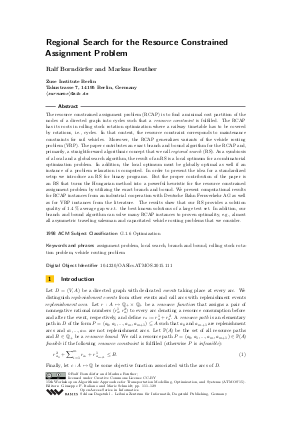Regional Search for the Resource Constrained Assignment Problem
Authors Ralf Borndörfer, Markus Reuther
-
Part of:
Volume:
15th Workshop on Algorithmic Approaches for Transportation Modelling, Optimization, and Systems (ATMOS 2015)
Part of: Series: Open Access Series in Informatics (OASIcs)
Part of: Conference: Symposium on Algorithmic Approaches for Transportation Modelling, Optimization, and Systems (ATMOS) - License:
 Creative Commons Attribution 3.0 Unported license
Creative Commons Attribution 3.0 Unported license
- Publication Date: 2015-09-14
File

PDF
OASIcs.ATMOS.2015.111.pdf
- Filesize: 0.6 MB
- 19 pages
Document Identifiers
Subject Classification
Keywords
- assignment problem
- local search
- branch and bound
- rolling stock rota- tion problem
- vehicle routing problem
Metrics
- Access Statistics
-
Total Accesses (updated on a weekly basis)
0Document
0Metadata
Abstract
The resource constrained assignment problem (RCAP) is to find a minimal cost partition of the nodes of a directed graph into cycles such that a resource constraint is fulfilled. The RCAP has its roots in rolling stock rotation optimization where a railway timetable has to be covered by rotations, i.e., cycles. In that context, the resource constraint corresponds to maintenance constraints for rail vehicles. Moreover, the RCAP generalizes variants of the vehicle routing problem (VRP). The paper contributes an exact branch and bound algorithm for the RCAP and, primarily, a straightforward algorithmic concept that we call regional search (RS). As a symbiosis of a local and a global search algorithm, the result of an RS is a local optimum for a combinatorial optimization problem. In addition, the local optimum must be globally optimal as well if an instance of a problem relaxation is computed. In order to present the idea for a standardized setup we introduce an RS for binary programs. But the proper contribution of the paper is an RS that turns the Hungarian method into a powerful heuristic for the resource constrained assignment problem by utilizing the exact branch and bound. We present computational results for RCAP instances from an industrial cooperation with Deutsche Bahn Fernverkehr AG as well as for VRP instances from the literature. The results show that our RS provides a solution quality of 1.4 % average gap w.r.t. the best known solutions of a large test set. In addition, our branch and bound algorithm can solve many RCAP instances to proven optimality, e.g., almost all asymmetric traveling salesman and capacitated vehicle routing problems that we consider.
Cite As Get BibTex
Ralf Borndörfer and Markus Reuther. Regional Search for the Resource Constrained Assignment Problem. In 15th Workshop on Algorithmic Approaches for Transportation Modelling, Optimization, and Systems (ATMOS 2015). Open Access Series in Informatics (OASIcs), Volume 48, pp. 111-129, Schloss Dagstuhl – Leibniz-Zentrum für Informatik (2015)
https://doi.org/10.4230/OASIcs.ATMOS.2015.111
BibTex
@InProceedings{borndorfer_et_al:OASIcs.ATMOS.2015.111,
author = {Bornd\"{o}rfer, Ralf and Reuther, Markus},
title = {{Regional Search for the Resource Constrained Assignment Problem}},
booktitle = {15th Workshop on Algorithmic Approaches for Transportation Modelling, Optimization, and Systems (ATMOS 2015)},
pages = {111--129},
series = {Open Access Series in Informatics (OASIcs)},
ISBN = {978-3-939897-99-6},
ISSN = {2190-6807},
year = {2015},
volume = {48},
editor = {Italiano, Giuseppe F. and Schmidt, Marie},
publisher = {Schloss Dagstuhl -- Leibniz-Zentrum f{\"u}r Informatik},
address = {Dagstuhl, Germany},
URL = {https://drops.dagstuhl.de/entities/document/10.4230/OASIcs.ATMOS.2015.111},
URN = {urn:nbn:de:0030-drops-54536},
doi = {10.4230/OASIcs.ATMOS.2015.111},
annote = {Keywords: assignment problem, local search, branch and bound, rolling stock rota- tion problem, vehicle routing problem}
}
Author Details
References
-
Tobias Achterberg. Constraint Integer Programming. PhD thesis, Technische Universität Berlin, 2009.

-
M. L. Balinski and R. E. Gomory. A primal method for the assignment and transportation problems. Management Science, 10(3):578-593, 1964.

-
M. L. Balinski and Andrew Russakoff. On the assignment polytope. SIAM Review, 16(4):pp. 516-525, 1974.

-
Timo Berthold. Heuristic algorithms in global MINLP solvers. PhD thesis, Technische Universität Berlin, 2014.

-
G. Clarke and J. W. Wright. Scheduling of vehicles from a central depot to a number of delivery points. Operations Research, 12(4):568-581, 1964.

-
Matteo Fischetti and Andrea Lodi. Local branching. Mathematical Programming, 98(1-3):23-47, 2003.

-
Matteo Fischetti, Paolo Toth, and Daniele Vigo. A Branch-and-Bound Algorithm for the Capacitated Vehicle Routing Problem on Directed Graphs. Operations Research, 42(5):846–859, 1994.

-
Steven Fortune, John Hopcroft, and James Wyllie. The directed subgraph homeomorphism problem. Theoretical Computer Science, 10(2):111–121, 1980.

-
Chris Groër, Bruce Golden, and Edward Wasil. A library of local search heuristics for the vehicle routing problem. Mathematical Programming Computation, 2(2):79–101, 2010.

-
Keld Helsgaun. General k-opt submoves for the Lin–Kernighan TSP heuristic. Mathematical Programming Computation, 1(2-3):119–163, 2009.

-
H. W. Kuhn. The hungarian method for the assignment problem. Naval Research Logistics Quarterly, 2(1-2):83-97, 1955.

-
Silvano Martello and Paolo Toth. Lower bounds and reduction procedures for the bin packing problem. Discrete Applied Mathematics, 28(1):59–70, 1990.

-
Diego Pecin, Artur Pessoa, Marcus Poggi, and Eduardo Uchoa. Improved Branch-Cut-and-Price for Capacitated Vehicle Routing. In Jon Lee and Jens Vygen, editors, Integer Programming and Combinatorial Optimization, volume 8494 of Lecture Notes in Computer Science, page 393–403. Springer International Publishing, 2014.

-
T. Ralphs. Branch cut and price resource web (http://www.branchandcut.org), June 2014.

-
G. Reinelt. TSPLIB - A T.S.P. Library. Technical Report 250, Universität Augsburg, Institut für Mathematik, Augsburg, 1990.

-
Markus Reuther. Local Search for the Resource Constrained Assignment Problem. In 14th Workshop on Algorithmic Approaches for Transportation Modelling, Optimization, and Systems, volume 42 of OASIcs, pages 62-78, Dagstuhl, Germany, 2014. Schloss Dagstuhl-Leibniz-Zentrum fuer Informatik.

-
Markus Reuther, Ralf Borndörfer, Thomas Schlechte, and Steffen Weider. Integrated optimization of rolling stock rotations for intercity railways. In Proceedings of RailCopenhagen, Copenhagen, Denmark, May 2013.

-
Yossi Shiloach. The two paths problem is polynomial. Technical report, Stanford University, Stanford, CA, USA, 1978.

-
P. Toth and D. Vigo. Vehicle Routing. Society for Industrial and Applied Mathematics, Philadelphia, PA, 2014.

-
Marcel Turkensteen, Diptesh Ghosh, Boris Goldengorin, and Gerard Sierksma. Tolerance-based Branch and Bound algorithms for the ATSP. EJOR, 189(3):775–788, 2008.

